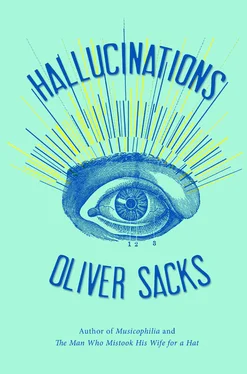For most people, focal seizures always consist of the same symptoms repeated with little or no variation, but others may have a large repertoire of auras. Amy Tan, the novelist, whose epilepsy may have been caused by Lyme disease, described her hallucinations to me.
“When I realized the hallucinations were seizures,” she said, “I found them fascinating as brain quirks. I tried to notice the details of the ones that repeated.” And, being a writer, she gave all of her repeating hallucinations names. The most frequent one she calls the “Illuminated Spinning Odometer.” She describes it as
what you might see on the dash of your car at night … except the numbers begin spinning more and more rapidly, like a gas pump giving you a running tally of the cost of gas. After about twenty seconds, the numbers begin to disintegrate and the odometer itself falls apart, and gradually disappears. Because it happened so often … I made it a game to see if I could name the numbers as they were falling, or to see if I could control the speed of the odometer or make the hallucination last longer. I could not.
None of her other hallucinations moved. For a time, she would often see
the figure of a woman in long white Victorian dress in the foreground of a scene with other people in the background. It looked like a faint Victorian photograph, or a black and white version of one of those Renoir paintings of people in the park.… The figure was not looking at me, not moving.… I did not mistake it as a live scene or real people. The image had no significance to anything in my life. I did not feel any heightened emotions associated with it.
She sometimes has unpleasant odor hallucinations or physical sensations, “the ground beneath me wobbling, for instance,” she says, adding, “I have to ask others if an earthquake is happening.”
She often experiences déjà vu but finds her occasional jamais vu much more disturbing:
The first time it happened, I remember looking at a building I had passed hundreds of times and thinking I had never noticed it was that color or shape, etc. And I then looked at everything around me, and none of it looked familiar. It was so disorienting I could not move an inch further. In the same way, I would sometimes not recognize my home, but I knew I was in my home. I had learned to be patient and wait for it to pass in twenty or thirty seconds.
Amy remarks that her seizures most often occur when she is waking up or dozing off. She occasionally sees “Hollywood aliens” dangling from the ceiling. They look like “someone’s inept attempt to make an alien creature for a movie set … like a spider with a Darth Vader–like helmet head.”
She emphasizes that the images have no personal relevance, are not related to anything that happened that day, and carry no special associations or emotional significance. “They do not stay in my mind as anything to think about,” she observes. “They are more like the detritus of those parts of dreams that mean nothing, like random images arbitrarily flashed in front of me.”
Stephen L., an affable, outgoing man, first consulted me in the summer of 2007. He brought with him his “neurohistory,” as he called it — seventeen pages of single-spaced typing — adding that he had “a little graphomania.” He said his problems started after an accident thirty years before, when his car was broadsided by another, and his head slammed against the windshield. He suffered a severe concussion but seemed to recover fully after a few days. Two months later, he started to have brief attacks of déjà vu: he would suddenly feel that whatever he was experiencing, doing, thinking, or feeling he had already experienced, done, thought, or felt before. At first he was intrigued by these brief convictions of familiarity and found them pleasant (“like the breeze going past my face”), but within a few weeks he was getting them thirty or forty times a day. On one occasion, to prove that the feeling of familiarity was an illusion, he stamped his foot, threw one leg high in the air, and did a sort of Highland fling in front of a washroom mirror. He knew he had never done such a thing before, but it felt as though he were repeating something he had done many times.
His attacks became not only more frequent but more complex, the déjà vu being only the start of a “cascade” (as he put it) of other experiences, which, once started, would move forward irresistibly. The déjà vu would be followed by a sharp icy or burning pain in the chest, then by an alteration of hearing, so that sounds become louder, more resonant, seemed to reverberate all around him. He might hear a song as clearly as if it were being sung in the next room, and what he heard would always be a specific performance of the song — for example, a particular Neil Young song (“After the Gold Rush”) exactly as he had heard it during a concert at his college the year before. He might then go on to experience “a bland, pungent smell” and a taste “which corresponded with the smell.”
On one occasion Stephen dreamt he was having one of his aura cascades and woke to find that he was indeed in the midst of one. But then to the usual cascade was added a strange out-of-body experience, in which he seemed to be looking down at his body as it lay in bed, through an elevated open window. This out-of-body experience seemed real — and very frightening. Frightening, in part, because it suggested to him that more and more of his brain was being involved in his seizures, and that things were getting out of control.
Nonetheless, he kept these attacks to himself until Christmas of 1976, when he had a convulsion, a grand mal seizure; he was in bed with a girl at the time, and she described it to him. He consulted a neurologist, who confirmed that he had temporal lobe epilepsy, probably caused by injury to the right temporal lobe sustained during the car crash. He was put on antiepileptics — first one, then others — but he continued to have temporal lobe seizures almost daily and two or more grand mal seizures a month. Finally, after thirteen years of trying different antiepileptic medications, Stephen consulted another neurologist for evaluation and consideration of possible surgery.
In 1990, Stephen had surgery to remove an epileptic focus in his right temporal lobe, and he felt so much better after the surgery that he decided to wean himself off medication. Then, unfortunately, he had another car accident, after which his seizures returned. These were not responsive to medication, and he had to have much more extensive brain surgery in 1997. Nevertheless, he continues to need antiepileptic medication and to have various seizure symptoms.
Stephen feels that there has been a “metamorphosis” in his personality since the start of his seizures, that he has become “more spiritual, more creative, more artistic” — specifically, he wonders whether “the right side” of his brain (as he puts it) is being stimulated, coming to dominate him. In particular, music has assumed greater and greater importance for him. He had taken up the harmonica in his college days, and now, in his fifties, he plays “obsessively,” for hours. He often writes or draws for hours at a time, too. He feels that his personality has become “all or none” — he may be either hyperfocused or completely distracted. He has also developed a tendency to sudden rage: on one occasion, when a car cut him off, he attacked the offender physically, hurling a can at his car, then punching him. (He wonders, in retrospect, whether some seizure activity played a part in this.) Despite all his problems, Stephen L. is able to continue working in medical research, and he remains an engaging, sensitive, and creative person.
There was little that Gowers or his contemporaries could do for patients with complex or focal seizures, other than giving them sedative drugs like bromides. Many patients with epilepsy, especially temporal lobe epilepsy, were considered to be “medically intractable” until the introduction of the first specific antiepileptic drug in the 1930s — and even then the most severely affected patients could not be helped. But the 1930s also saw a much more radical, surgical approach, undertaken by Wilder Penfield, a brilliant young American neurosurgeon working in Montreal, and his colleague Herbert Jasper. In order to remove the epileptic focus in the cerebral cortex, Penfield and Jasper first had to find it by mapping the patient’s temporal lobe, and this required the patient to be fully conscious. (Local anesthesia is used when opening the skull, but the brain itself is insensitive to touch and pain.) Over a twenty-year period, the “Montreal procedure” was carried out in more than five hundred patients with temporal lobe epilepsy. These people had very diverse seizure symptoms, but forty or so of them had what Penfield termed “experiential seizures,” in which, seemingly, a fixed and vivid memory of the past would suddenly burst into the mind with hallucinatory force, causing a doubling of consciousness: a patient would feel equally that he was in the operating room in Montreal and that he was, say, riding horseback in a forest. By systematically going over the surface of the exposed temporal cortex with his electrodes, Penfield was able to find particular cortical points in each patient where stimulation caused a sudden, involuntary recall — an experiential seizure. 45 45 Penfield was a great physiologist as well as a neurosurgeon, and in the process of searching for epileptic foci, he was able to map most of the basic functions of the living human brain. He showed, for example, exactly where sensations and movements of specific body parts were represented in the cerebral cortex — his sensory and motor homunculi are iconic. Like Weir Mitchell, Penfield was an engaging writer, and after he and Herbert Jasper published their magnum opus, Epilepsy and the Functional Anatomy of the Human Brain , in 1958, he continued to write about the brain, as well as writing novels and biographies, until his death at eighty-six.
Removal of these points could prevent further such seizures, without affecting the memory itself.
Читать дальше












